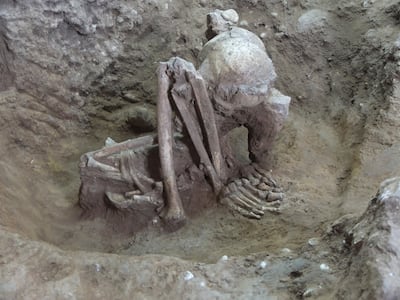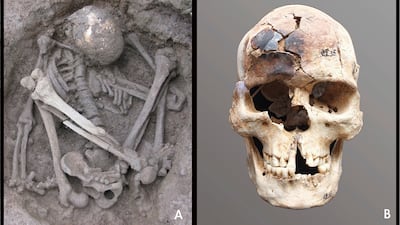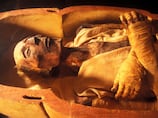Scientists may have found what are thought to be the world's oldest mummies in southeastern Asia.
A study published in the journal Proceedings of the National Academy of Sciences claims that the mummies could be 4,000 to 12,000 years old.
The finding documents smoke-dried mummification of the dead, mostly in tightly bound crouched postures, across a vast region encompassing southeastern Asia, southern China and beyond.
The human remains discovered show some cuts and burn marks. According to scientists, the bodies were probably smoke-dried over a fire and mummified by hunter-gatherer communities in the area.
To assess potential heat exposure in the skeletal remains, X-ray diffraction analysis was conducted on 20 archaeological bone samples from sites in Vietnam. The technique is particularly effective in detecting high-temperature thermal alterations.

The oldest of these newly-discovered burials predate the mummification associated with the Chinchorro culture, approximately 7,000 years ago in northern Chile, and Ancient Egypt, approximately 4,500 years ago.
Mummification is the process of preserving a dead body by preventing decay. The methods of embalming or treating a body were most famously used by Egyptians. The process involved removing all moisture, leaving only a dried form that would not easily decay.
Natural mummification involves preservation by environment through processes like desiccation in hot and dry climates or freeze-drying in extreme cold.
Haircare resolutions 2021
From Beirut and Amman to London and now Dubai, hairstylist George Massoud has seen the same mistakes made by customers all over the world. In the chair or at-home hair care, here are the resolutions he wishes his customers would make for the year ahead.
1. 'I will seek consultation from professionals'
You may know what you want, but are you sure it’s going to suit you? Haircare professionals can tell you what will work best with your skin tone, hair texture and lifestyle.
2. 'I will tell my hairdresser when I’m not happy'
Massoud says it’s better to offer constructive criticism to work on in the future. Your hairdresser will learn, and you may discover how to communicate exactly what you want more effectively the next time.
3. ‘I will treat my hair better out of the chair’
Damage control is a big part of most hairstylists’ work right now, but it can be avoided. Steer clear of over-colouring at home, try and pursue one hair brand at a time and never, ever use a straightener on still drying hair, pleads Massoud.
Specs
Engine: 51.5kW electric motor
Range: 400km
Power: 134bhp
Torque: 175Nm
Price: From Dh98,800
Available: Now
Company%20Profile
The%20specs
Test
Director: S Sashikanth
Cast: Nayanthara, Siddharth, Meera Jasmine, R Madhavan
Star rating: 2/5
UPI facts
More than 2.2 million Indian tourists arrived in UAE in 2023
More than 3.5 million Indians reside in UAE
Indian tourists can make purchases in UAE using rupee accounts in India through QR-code-based UPI real-time payment systems
Indian residents in UAE can use their non-resident NRO and NRE accounts held in Indian banks linked to a UAE mobile number for UPI transactions
CHATGPT%20ENTERPRISE%20FEATURES
Match info
Wolves 0
Arsenal 2 (Saka 43', Lacazette 85')
Man of the match: Shkodran Mustafi (Arsenal)
Business Insights
- As per the document, there are six filing options, including choosing to report on a realisation basis and transitional rules for pre-tax period gains or losses.
- SMEs with revenue below Dh3 million per annum can opt for transitional relief until 2026, treating them as having no taxable income.
- Larger entities have specific provisions for asset and liability movements, business restructuring, and handling foreign permanent establishments.
Full Party in the Park line-up
2pm – Andreah
3pm – Supernovas
4.30pm – The Boxtones
5.30pm – Lighthouse Family
7pm – Step On DJs
8pm – Richard Ashcroft
9.30pm – Chris Wright
10pm – Fatboy Slim
11pm – Hollaphonic
The specs: 2018 Alfa Romeo Stelvio
Price, base: Dh198,300
Engine: 2.0L in-line four-cylinder
Transmission: Eight-speed automatic
Power: 280hp @ 5,250rpm
Torque: 400Nm @ 2,250rpm
Fuel economy, combined: 7L / 100km
We Weren’t Supposed to Survive But We Did
We weren’t supposed to survive but we did.
We weren’t supposed to remember but we did.
We weren’t supposed to write but we did.
We weren’t supposed to fight but we did.
We weren’t supposed to organise but we did.
We weren’t supposed to rap but we did.
We weren’t supposed to find allies but we did.
We weren’t supposed to grow communities but we did.
We weren’t supposed to return but WE ARE.
Amira Sakalla
On Women's Day
Dr Nawal Al-Hosany: Why more women should be on the frontlines of climate action
Samar Elmnhrawy: How companies in the Middle East can catch up on gender equality
The National Editorial: Is there much to celebrate on International Women's Day 2021?
Justin Thomas: Challenge the notion that 'men are from Mars, women are from Venus'
COMPANY PROFILE
While you're here
Hussein Ibish: Could it be game over for Donald Trump?
Joyce Karam: Trump's campaign thrown off balance
Trump tests positive: everything we know so far
What is a robo-adviser?
Robo-advisers use an online sign-up process to gauge an investor’s risk tolerance by feeding information such as their age, income, saving goals and investment history into an algorithm, which then assigns them an investment portfolio, ranging from more conservative to higher risk ones.
These portfolios are made up of exchange traded funds (ETFs) with exposure to indices such as US and global equities, fixed-income products like bonds, though exposure to real estate, commodity ETFs or gold is also possible.
Investing in ETFs allows robo-advisers to offer fees far lower than traditional investments, such as actively managed mutual funds bought through a bank or broker. Investors can buy ETFs directly via a brokerage, but with robo-advisers they benefit from investment portfolios matched to their risk tolerance as well as being user friendly.
Many robo-advisers charge what are called wrap fees, meaning there are no additional fees such as subscription or withdrawal fees, success fees or fees for rebalancing.
The past Palme d'Or winners
2018 Shoplifters, Hirokazu Kore-eda
2017 The Square, Ruben Ostlund
2016 I, Daniel Blake, Ken Loach
2015 Dheepan, Jacques Audiard
2014 Winter Sleep (Kış Uykusu), Nuri Bilge Ceylan
2013 Blue is the Warmest Colour (La Vie d'Adèle: Chapitres 1 et 2), Abdellatif Kechiche, Adele Exarchopoulos and Lea Seydoux
2012 Amour, Michael Haneke
2011 The Tree of Life, Terrence Malick
2010 Uncle Boonmee Who Can Recall His Past Lives (Lung Bunmi Raluek Chat), Apichatpong Weerasethakul
2009 The White Ribbon (Eine deutsche Kindergeschichte), Michael Haneke
2008 The Class (Entre les murs), Laurent Cantet
COMPANY%20PROFILE
• Remittance charges will be tackled by blockchain
• UAE's monumental and risky Mars Mission to inspire future generations, says minister
• Could the UAE drive India's economy?
• News has a bright future and the UAE is at the heart of it
• Architecture is over - here's cybertecture
• The National announces Future of News journalism competition
• Round up: Experts share their visions of the world to come
AWARDS
TECH%20SPECS%3A%20APPLE%20WATCH%20SERIES%209
Profile of Tarabut Gateway
Founder: Abdulla Almoayed
Based: UAE
Founded: 2017
Number of employees: 35
Sector: FinTech
Raised: $13 million
Backers: Berlin-based venture capital company Target Global, Kingsway, CE Ventures, Entrée Capital, Zamil Investment Group, Global Ventures, Almoayed Technologies and Mad’a Investment.
Dust and sand storms compared
Sand storm
- Particle size: Larger, heavier sand grains
- Visibility: Often dramatic with thick "walls" of sand
- Duration: Short-lived, typically localised
- Travel distance: Limited
- Source: Open desert areas with strong winds
Dust storm
- Particle size: Much finer, lightweight particles
- Visibility: Hazy skies but less intense
- Duration: Can linger for days
- Travel distance: Long-range, up to thousands of kilometres
- Source: Can be carried from distant regions



